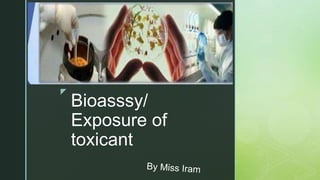
bioassay.pptx
- 2. z Bioassay It is defined as a test to evaluate the relative potential of a chemical by comparing its effect on a living organism with that of a standard preparation . It is performed to determine the strength of the chemical from the degree of response included in the test organism and to estimate the concentration of the chemical that is toxic to those organisms a toxicity test is performed to measure the degree of response produced by a specific level of stimulus that is to test chemical concentration
- 3. z Acute toxicity The toxicity that causes injury or that from a single or multiple exposure over a short period of time usually 24 hours. It acute exposure organist can come in contact with the chemical delivered in single event or in multiple event for generally hours or days. Acute exposure of chemical toxic and also produce harmful effects immediate to chronic exposure
- 4. z Chronic toxicity In chronic exposure to organisms oftoxicconcentration continuously over a long period of time that is week month or year chronic toxicity test important tools for understanding in evaluating the potential hazards to chemical to organise bioessays mainly done for the two purple detection of polytene and to determine the event of damage and ill effect
- 5. z Procedure of bioassay 1. Selection of experimental animal 2. safe dose 3. mode of Administration 4. Duration 5. dissection 6. observation 7. conclusion
- 6. z Selection of experimental animal The animal upon which experiment has to be done is selected it should be easy to handle or not too large or too big less body weight should be there generally the animal selected is B rattus norvegicus Albino rat
- 7. z Safe dose The toxicity of a chemical to an organism is usually expressed ld50 lc50 that is Lethal dose in Terrestrial animal and Lethal concentration for aquatic animals
- 8. z LD50 It is the amount of poison for Unit Weight of the organ use which is required to kill 50% of the test population. It is generally measured in MG or per kg of body weight therefore ld50 is the dose required to kill 50% of the animal population
- 9. z LC 50 It is the concentration of a chemical that could produce a mortality in 50% of population of their step of the test species it is calculated in parts per million
- 10. z Mode of Administration It is the stuff that the top of the Cantor chemical is introduced into the experimental animal by several means that is oral inhalation injection ingestion
- 11. z Duration/ Time Period It is the time period for the action of public and that is expressed by LT 50 Lethal time ld50 is the time required for 50% mortality of test organism
- 12. z Dissection The animal is dissected to see effect of public and on the interior body of the organs
- 13. z Observation Animal is observed for the estimation of toxicity of chemical upon various vital organ of the body. The conclusion that is made after observation either the chemical is toxicant or not Conclusions
- 14. z Application Bioassay are frequently used in the pharmaceutical industries to evaluate the potential of drug and medicine Different organisms have been used to study the toxic effects of the chemical exampleRats,rabbit and monkey . Bioassay test are used to estimate acute, subacute, chronic and subchronic toxicity of Chemical on animals . To test toxicity or bioassay of aquatic animal is done by exposing the toxicant for a definite period in the water
- 15. z Dose response relationship Chemical that produce its response or its ill effect when its concentration in tissues cells or organ attain some critical minimum level. Rate of absorption it is the rate at which the toxic and is absorbed by the organism inside his body
- 16. z Rate of expression it is the rate at which the toxic and is removed from organised body through urine and excreta. detoxification the detoxification organ in mammal is liver which contain cytochrome P450 oxidases, UDP glucuronosyltransferases which help indetoxification and harmful substance in the harmless chemical in body . hence the amount and rate at which the detoxification is done by liver also an important factor of dose response relationship
- 17. z Distribution it means whether the toxicants is distributed in the whole body or concentration in a particular body parts cell tissue organ. tolerance it is the power of the organ is to with stand the effect of toxic and for definite time period every organelles has different body tolerance for different toxicant . concentration of dose It is the amount of those given to the organelles that is quantity of the toxic and duration and time period did the period for which the toxic and is given that is acute or chronic